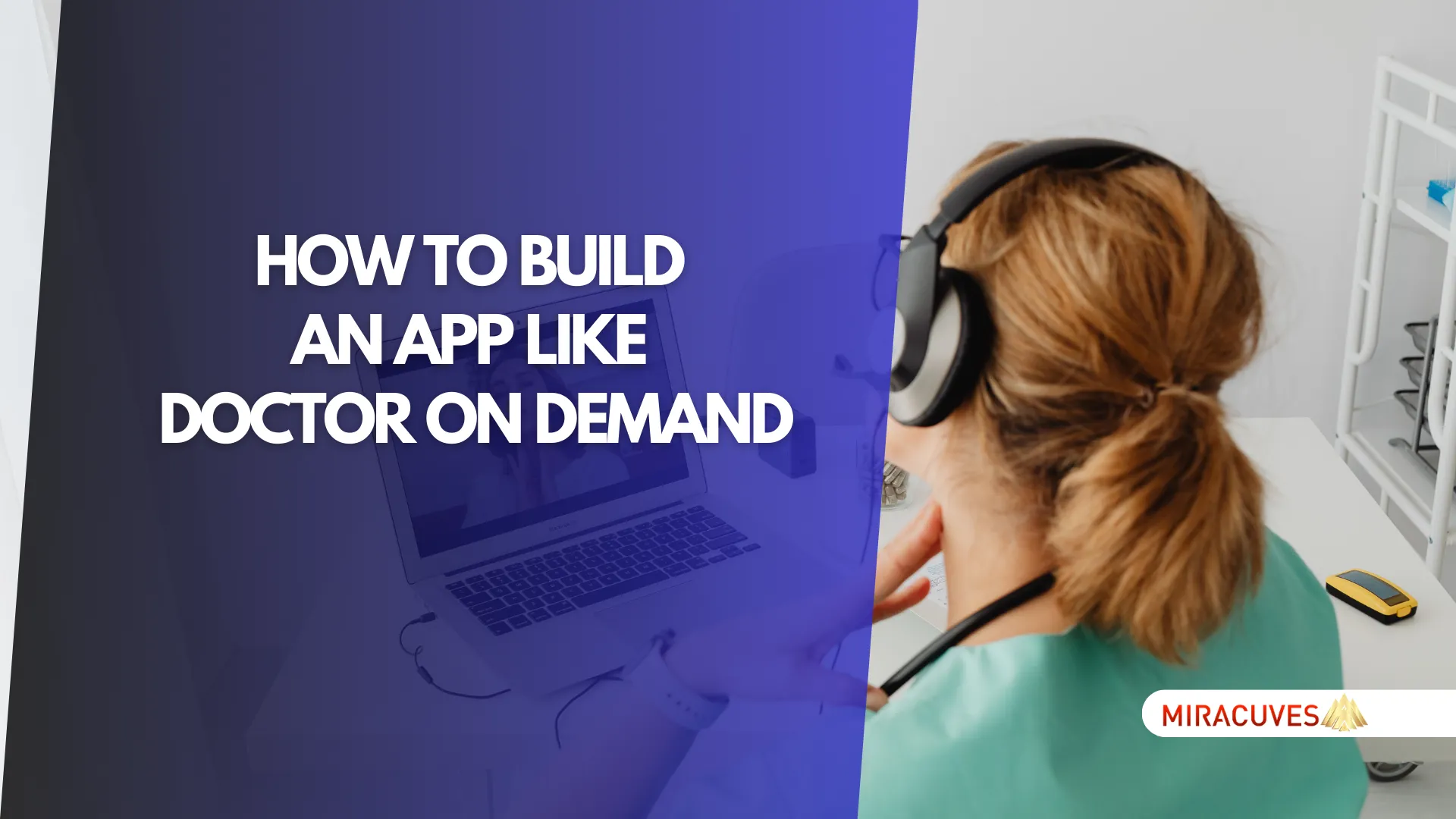In today’s fast-paced world, access to healthcare has never been more important. With the rising demand for telemedicine, apps like Doctor on Demand have revolutionized the way patients interact with healthcare professionals. Whether it’s a routine consultation, mental health support, or urgent care, platforms like Doctor on Demand bridge the gap between patients and doctors, offering healthcare from the comfort of home.
But how can you build an app that offers the same seamless experience as Doctor on Demand? And more importantly, how can you do it without breaking the bank or spending months in development? That’s where Miracuves Solutions comes in, offering ready-made app solutions that cut both cost and time significantly, allowing you to bring your telemedicine app to life in just 10 days, and at 10% of the global development cost.
In this guide, we’ll take you through the key features, development process, and cost breakdown of building an app like Doctor on Demand—providing you with everything you need to launch a successful telemedicine platform in record time.
What is Doctor on Demand and What Does It Do?
| Feature | Doctor on Demand | Amwell | Teladoc |
|---|---|---|---|
| Video Consultations | Yes | Yes | Yes |
| Prescription Services | Yes | Yes | Yes |
| Mental Health Support | Yes | Yes | Yes |
| Primary Care | Yes | Yes | Yes |
| Chronic Care Management | Yes | Yes | Yes |
| Insurance Integration | Yes | Yes | Yes |
| 24/7 Access | Yes | Yes | Yes |
| Specialist Consultations | No | Yes | Yes |
| Custom Wellness Plans | No | Yes | No |
| Pricing | Affordable | Varies | Moderate |
Doctor on Demand is a telemedicine platform that connects patients with certified healthcare professionals through video consultations. It allows users to book appointments, receive medical advice, and even get prescriptions—all without needing to visit a doctor in person. The platform covers a wide range of services, including primary care, mental health counseling, and chronic care management. By providing access to healthcare from the comfort of home, Doctor on Demand has become a go-to solution for individuals seeking affordable and accessible medical care.
This app caters to a wide audience: from busy professionals who need quick consultations to individuals living in remote areas with limited access to healthcare facilities. The platform is user-friendly, offering features like easy registration, real-time video consultations, secure payment gateways, and access to prescription services. Its on-demand nature also means that users can access medical advice anytime, making healthcare more accessible than ever before.
With the COVID-19 pandemic pushing the adoption of telemedicine even further, apps like Doctor on Demand have witnessed exponential growth. The convenience of getting professional medical help remotely, coupled with the increasing demand for virtual healthcare, makes building a similar app not just a profitable venture, but a necessary one for the modern healthcare landscape.
Why Build This App?
| Cost Breakdown | Global App Development Cost | Miracuves Solutions Ready-Made Cost |
|---|---|---|
| Design & Prototyping | $1,500 – $2,500 | Included |
| Backend & Frontend Development | $3,000 – $5,000 | $300 |
| Testing & Quality Assurance | $1,000 – $1,500 | Included |
| Launch & Deployment | $500 – $1,000 | Included |
| Maintenance & Updates | $1,000+ annually | Included (first year) |
| Total Cost | $6,000 – $10,000 | $600 |
The healthcare landscape is shifting rapidly, with telemedicine becoming a cornerstone of modern care. Building an app like Doctor on Demand taps into this evolving trend, offering convenience, accessibility, and efficiency that traditional healthcare cannot always provide. But why is now the perfect time to build such an app?
The global telemedicine market is expected to grow at an annual rate of over 23% from 2023 to 2028, driven by increased smartphone usage, internet penetration, and the rising need for accessible healthcare. More patients are seeking remote consultations to save time and avoid hospital visits, and healthcare providers are embracing this technology to reach a broader audience. This growing demand creates a huge opportunity for businesses to build telemedicine platforms that can serve millions of users globally.
In addition to market potential, building a Doctor on Demand-like app offers a streamlined solution for improving healthcare outcomes. By giving users the ability to connect with medical professionals on demand, the app addresses issues of accessibility, especially in rural or underserved areas. Plus, with telemedicine services becoming more integrated with health insurance plans, patients are now more willing to adopt digital healthcare solutions.
Investing in an app like this not only opens up new revenue streams—through subscriptions, pay-per-consultation, or partnerships with healthcare providers—but also positions your business in a fast-growing sector where the demand for virtual healthcare continues to soar.
How to Differentiate Your App from Others
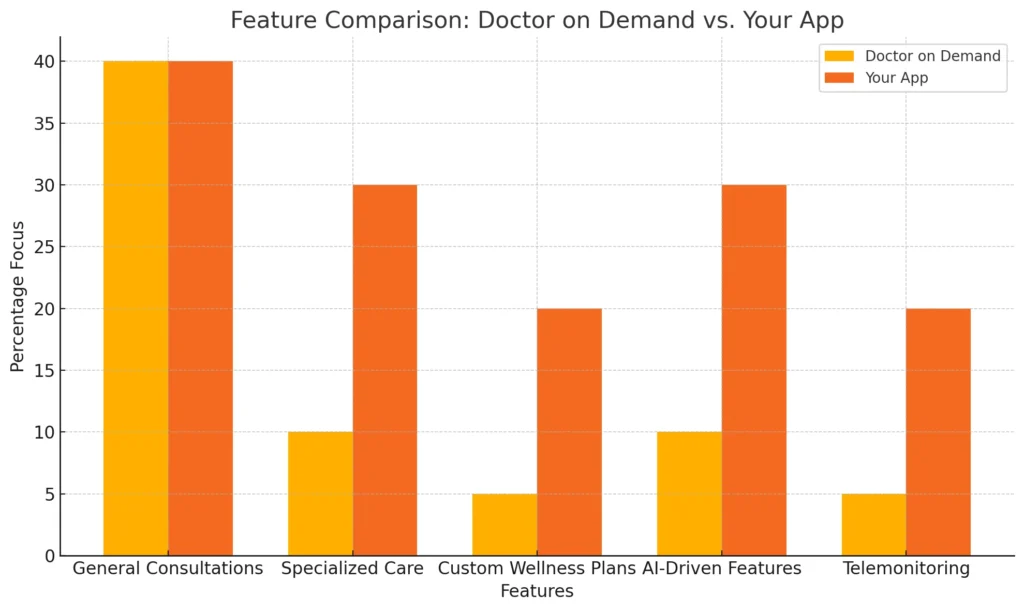
With the rise in telemedicine apps, it’s essential to find ways to stand out in the crowd. While apps like Doctor on Demand have set a strong foundation, there’s still plenty of room for innovation. Differentiating your app means offering features or services that are either missing or underdeveloped in current telemedicine platforms.
One way to stand out is by enhancing specialist care options. While many apps focus primarily on general consultations, offering specialized services in areas like dermatology, pediatrics, or mental health can cater to niche markets. Additionally, integrating AI-driven features such as symptom checkers or personalized health insights can make the app more interactive and data-driven, giving users tailored advice before or after their consultation.
Another key differentiator could be the introduction of custom wellness plans. By providing users with personalized plans that focus on long-term health goals—whether that’s weight management, chronic disease management, or mental health improvement—your app can shift from being a reactive healthcare tool to a proactive one.
Lastly, think about integrating advanced telemonitoring features that allow doctors to track patient health metrics remotely (e.g., heart rate, blood pressure, or glucose levels) using wearable devices. This can provide a continuous care experience, making it more convenient for patients and valuable for healthcare providers looking to improve patient outcomes.
Market Size, Growth, Revenue, and Business Model
| Region/Category | 2023 Market Size (USD) | 2028 Projected Market Size (USD) | Growth Rate (%) |
|---|---|---|---|
| North America | $45 billion | $90 billion | 20% |
| Europe | $35 billion | $70 billion | 19% |
| Asia-Pacific | $25 billion | $55 billion | 24% |
| Teleconsultation Services | $50 billion | $120 billion | 25% |
| Mental Health Services | $15 billion | $40 billion | 27% |
| Chronic Disease Management | $10 billion | $30 billion | 30% |
The telemedicine market is booming, and for good reason. With more people opting for remote healthcare solutions, the global telemedicine market is expected to reach over $186 billion by 2028. This massive growth is being fueled by an increasing demand for convenience, technological advancements, and a shift in patient preferences toward virtual consultations.
Telemedicine apps like Doctor on Demand are tapping into a lucrative business model that combines subscription-based services, pay-per-visit fees, and partnerships with healthcare providers. By offering a variety of services, such as mental health counseling, primary care, and even specialist consultations, these apps can serve multiple patient needs while generating various revenue streams.
In terms of market segmentation, telemedicine isn’t just growing in urban areas. Rural regions, where access to healthcare is limited, are driving demand for virtual healthcare platforms. Additionally, as insurance providers increasingly cover telemedicine services, patient adoption is becoming easier, creating further room for growth.
This growth isn’t limited to just consultations. The addition of prescription services, wellness programs, and chronic disease management is adding new layers of revenue potential. By positioning your app to cater to these trends, you can tap into a growing user base while leveraging a business model that ensures sustainability and profitability.
Features of Doctor on Demand
| Feature | Included in MVP | Post-MVP Feature |
|---|---|---|
| Video Consultations | Yes | No |
| Appointment Scheduling | Yes | No |
| Prescription Services | Yes | No |
| User Profiles & Medical History | Yes | No |
| Payment Gateway | Yes | No |
| Ratings and Reviews | No | Yes |
| Specialist Consultations | No | Yes |
| Telemonitoring Features | No | Yes |
| AI-Driven Symptom Checker | No | Yes |
| Custom Wellness Plans | No | Yes |
When building an app like Doctor on Demand, it’s crucial to understand the features that make it successful. These core features not only provide value to the users but also ensure a smooth and efficient experience for both patients and healthcare providers. Here’s a breakdown of the essential features your app should include:
- Video Consultations: This is the backbone of any telemedicine app. Users need to have the ability to connect with doctors via high-quality, real-time video calls for consultations. Ensuring a stable video interface with low latency is key to maintaining user trust.
- Appointment Scheduling: Patients should be able to book, reschedule, or cancel appointments with ease. An intuitive scheduling feature, combined with automated reminders, can greatly enhance user experience.
- Prescription Services: After a consultation, doctors should be able to prescribe medications directly through the app. Integrating this feature with local pharmacies or home delivery services adds a layer of convenience for users.
- User Profiles and Medical History: Allow users to create and maintain their health profiles, which store personal information and medical history. This helps doctors provide better, more informed consultations and improves overall care.
- Payment Gateway: Secure and seamless payment integration is a must. Offering multiple payment options, such as credit cards, PayPal, or insurance integration, will help users complete transactions with ease.
- Ratings and Reviews: Enabling users to rate doctors and leave reviews after consultations helps build credibility and trust within the platform. It also allows the platform to maintain high standards for healthcare providers.
Minimum Viable Product (MVP)
When developing a telemedicine app, it’s wise to start with an MVP (Minimum Viable Product). This version of the app should include the core features like video consultations, appointment scheduling, and payment gateways. The MVP allows you to test the market quickly and gather feedback, which can then be used to refine the product for future updates.
Starting with an MVP not only reduces costs but also shortens the development timeline, getting your app to market faster. It helps in validating the business idea and determining the viability of additional features, all while keeping initial investments low.
Technical Requirements
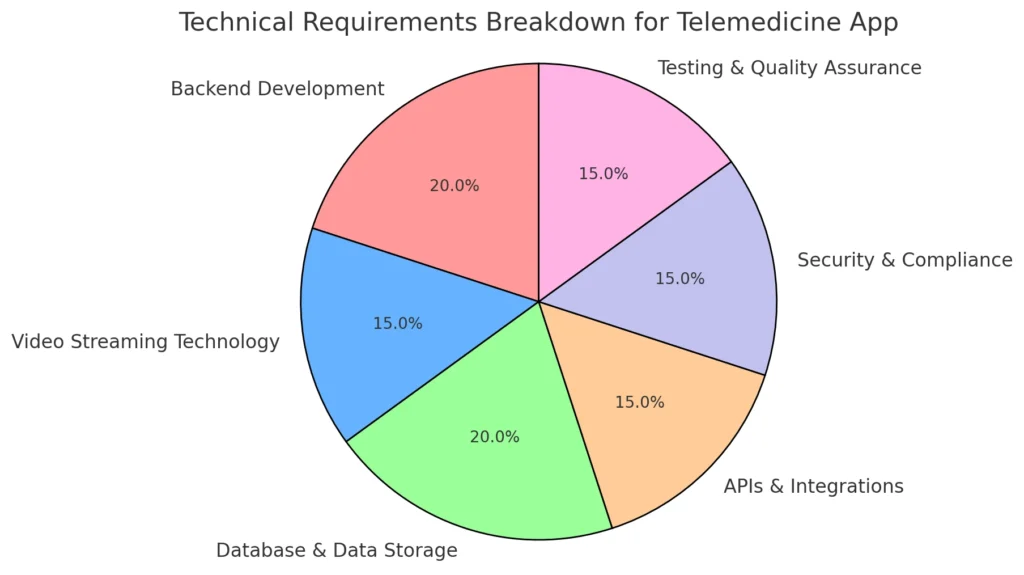
Building a robust and scalable telemedicine app like Doctor on Demand requires a strong technical foundation. The app needs to handle high volumes of user traffic, provide seamless video streaming, and ensure data security—all while maintaining a smooth user experience. Here’s a look at the technical requirements needed to create an app that stands up to the demands of the healthcare industry.
Backend Development
The backend is the backbone of your app, responsible for managing everything from user authentication to storing medical data. A reliable backend should be built using scalable technologies like Node.js, Ruby on Rails, or Python. These technologies are known for their scalability, performance, and ease of integration with third-party services like video conferencing APIs or payment gateways.
Video Streaming Technology
For high-quality video consultations, you’ll need to integrate a WebRTC or Twilio API, both of which are widely used for real-time communication. These technologies allow for secure, low-latency video calls, which are essential in the healthcare space, where consultations must be smooth and free of interruptions.
Database and Data Storage
Healthcare apps must handle sensitive patient data, so choosing the right database is critical. A HIPAA-compliant database like Firebase, PostgreSQL, or MongoDB ensures data is encrypted and securely stored. Implementing encryption at both rest and transit is crucial to protect user information from breaches.
APIs and Third-Party Integrations
Your app will likely require integration with various third-party services, such as payment gateways (e.g., Stripe, PayPal), prescription services, or insurance companies. Using RESTful APIs allows for seamless communication between your app and these services, making the overall user experience smooth and efficient.
Security and Compliance
Since you’ll be handling sensitive healthcare data, the app must be fully compliant with HIPAA (Health Insurance Portability and Accountability Act) and other data privacy regulations like GDPR. This includes ensuring that all patient-doctor communications are encrypted, user data is anonymized, and there is a clear consent process for users.
Testing and Quality Assurance
Rigorous testing is crucial for healthcare apps. Make sure your app undergoes unit testing, integration testing, and load testing to identify and fix any bugs before launch. Also, ensure that the app works flawlessly across all platforms (iOS, Android, and web) to provide a seamless experience for all users.
By focusing on these technical requirements, you can build a stable, secure, and high-performance telemedicine app that users trust with their healthcare needs.
This link directs to the official WebRTC page, a widely used real-time communication technology for video and voice in telemedicine apps, offering detailed resources about its integration.
Design and User Interface (UI/UX)
Design plays a pivotal role in the success of any app, and telemedicine apps are no different. A well-designed interface can significantly improve user experience, making it easy for patients to navigate the app and connect with healthcare professionals. When building an app like Doctor on Demand, it’s essential to prioritize both user-friendly navigation and a sleek, modern design that caters to a diverse audience, including individuals who may not be tech-savvy.
User-Centered Design
The key to successful app design is focusing on the needs of the end-users—patients and doctors. The app should be intuitive, with clear options for booking consultations, viewing medical records, and managing appointments. Simplicity is key. A clean, minimalistic design ensures users can navigate without confusion, reducing friction and improving satisfaction.
Mobile Responsiveness
Your app should be fully optimized for both iOS and Android devices, as mobile usage continues to dominate healthcare app interactions. Ensuring that the design is responsive on all screen sizes will create a seamless experience whether users are accessing the app on a smartphone, tablet, or desktop.
Easy Navigation
Creating an app with clear, logical navigation paths is crucial for ensuring users can access healthcare quickly. Whether it’s a patient seeking urgent care or a doctor managing appointments, the flow from screen to screen should be smooth and intuitive. For example, appointment booking should only take a few clicks, and accessing past medical records should be simple.
Visual Appeal and Branding
While functionality is important, the app’s visual appeal should not be overlooked. Using a cohesive color scheme that aligns with your brand helps in creating a professional appearance. In healthcare, it’s best to use calming, neutral tones like blues and greens, as these convey trust and reliability. The inclusion of professional imagery and easy-to-read typography also contributes to the overall aesthetic and user experience.
Accessibility
Telemedicine apps should be designed with accessibility in mind to accommodate users with disabilities. This includes integrating features like voice control, text-to-speech, and adjustable text sizes. Designing with accessibility standards ensures that your app can be used by a wider range of individuals, creating an inclusive platform for all patients.
By focusing on intuitive navigation, clean aesthetics, and mobile responsiveness, you’ll ensure that your telemedicine app is not only functional but also provides a superior user experience that keeps patients and doctors coming back.
Development Process (Step-by-Step)
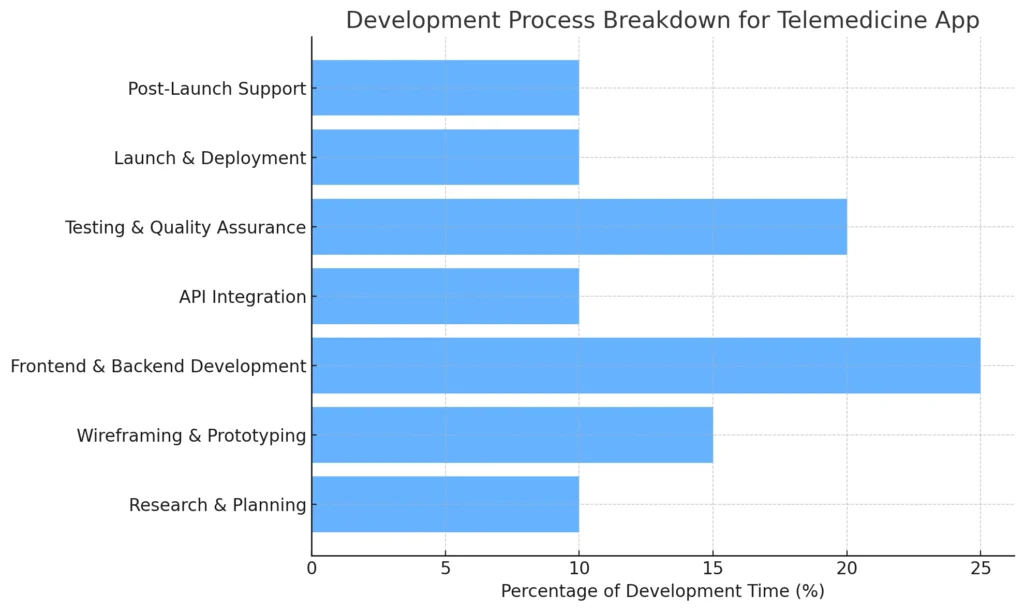
Developing an app like Doctor on Demand requires a well-organized process to ensure every aspect, from functionality to user experience, is covered. Each stage of development plays a crucial role in building a stable and efficient app that serves both patients and healthcare providers seamlessly. Here’s a step-by-step breakdown of the development process:
1. Research and Planning
The first step in developing a telemedicine app is conducting thorough research. This includes analyzing the target market, understanding user needs, and reviewing competitors. You’ll also need to define the scope of your app, deciding which features (such as video consultations, prescription services, etc.) are essential for the initial release.
Once the research is complete, you’ll move into the planning phase, where you map out the project timeline, define milestones, and set a budget. At this stage, it’s important to also identify the technical stack (backend, frontend, and APIs) that will be used to build the app.
2. Wireframing and Prototyping
Wireframes are simple sketches that outline the app’s layout and interface design. This step helps visualize how the app will look and function before development begins. Once the wireframes are approved, the next step is prototyping. Prototypes offer a clickable model of the app, allowing stakeholders to see the app in action and make any necessary adjustments to the user flow.
3. Frontend and Backend Development
Once the design is finalized, the actual development process begins. The frontend team works on building the user interface, ensuring it’s responsive and works across various devices. At the same time, the backend team develops the infrastructure that powers the app, including databases, servers, and APIs. This stage requires close collaboration between teams to ensure that all elements work together seamlessly.
4. Integration of Third-Party APIs
A telemedicine app often requires third-party integrations, such as video conferencing tools, payment gateways, and prescription services. During development, it’s crucial to securely integrate these APIs to ensure they function smoothly and meet compliance standards, particularly when handling sensitive medical data.
5. Testing and Quality Assurance
Once the development is complete, the app moves into the testing phase. Unit testing, integration testing, and user acceptance testing are conducted to identify and fix any bugs. It’s essential to ensure the app works flawlessly across all devices and that the user experience is smooth and intuitive. Additionally, performance testing is conducted to ensure the app can handle high traffic volumes without crashing.
6. Launch and Deployment
After passing the testing phase, the app is ready for deployment. The launch involves submitting the app to platforms like Google Play and the Apple App Store, ensuring it meets all their guidelines. At this stage, marketing efforts are also ramped up to create awareness and attract users to the newly launched app.
7. Post-Launch Support and Updates
The development process doesn’t end with the launch. Post-launch support is crucial to fix any unforeseen issues that arise and to release updates based on user feedback. Continuous improvement ensures the app remains relevant and competitive in the market.
Launch your on-demand
healthcare app faster!
Experience our customizable, user-friendly, and secure platform
designed to enhance patient satisfaction and
streamline doctor-patient interactions.
Cost Estimation and Timeframe
| Development Phase | Global Cost | Miracuves Solutions Cost | Global Timeframe | Miracuves Solutions Timeframe |
|---|---|---|---|---|
| Design & Prototyping | $1,500 – $2,500 | Included | 1-2 weeks | Included (Completed in 10 days) |
| Backend & Frontend Development | $3,000 – $5,000 | $300 | 2-3 weeks | Included (Completed in 10 days) |
| Testing & Quality Assurance | $1,000 – $1,500 | Included | 1 week | Included (Completed in 10 days) |
| Launch & Deployment | $500 – $1,000 | Included | 3-5 days | Included (Completed in 10 days) |
| Maintenance & Updates | $1,000+ annually | Included (First Year) | Ongoing | Included (First Year) |
| Total Cost | $6,000 – $10,000 | $600 | 1 month or more | 10 days |
One of the most important considerations when developing an app like Doctor on Demand is the cost and timeframe. Building a high-quality telemedicine app can be expensive, but with the right strategy, it doesn’t have to break the bank. Let’s dive into the cost breakdown and estimated timeframe for building such an app.
Cost Estimation
The total cost of developing a telemedicine app can vary greatly depending on factors like the complexity of features, the development team’s location, and the technology stack. Globally, developing a full-fledged telemedicine app could cost anywhere between $6,000 to $10,000. This includes design, development, testing, and deployment costs. However, Miracuves Solutions offers a competitive advantage by reducing the cost to 10% of the global price—bringing the price down to around $600.
Here’s a breakdown of the estimated costs for each phase:
- Design & Prototyping: $1,500 globally, but included with Miracuves
- Backend & Frontend Development: $3,000 – $5,000 globally, $300 with Miracuves
- Testing & Quality Assurance: $1,000 globally, included with Miracuves
- Launch & Deployment: $500 globally, included with Miracuves
- Maintenance & Updates: $1,000+ annually globally, included for the first year with Miracuves
By opting for ready-made solutions from Miracuves Solutions, you not only reduce development costs significantly but also speed up the time to market.
Timeframe
The traditional timeframe for developing a telemedicine app from scratch is around 1 month or more, depending on the complexity and the team’s availability. This includes planning, design, development, and testing. However, with Miracuves Solutions, the app can be built and launched in just 10 days, thanks to its ready-made solutions and streamlined development process.
Factors Affecting Cost and Time
- Feature Complexity: Adding more advanced features like AI-driven symptom checkers, telemonitoring, or custom wellness plans can increase both the cost and development time.
- Customization: While ready-made solutions are faster and more cost-effective, heavy customization may extend the development timeline slightly.
- Security & Compliance: Integrating HIPAA and GDPR compliance adds another layer of complexity, but it’s a non-negotiable aspect for telemedicine apps.
Monetization Strategies
Building a telemedicine app like Doctor on Demand presents not only a healthcare solution but also a potential revenue stream. Monetizing the app effectively is key to ensuring its long-term viability and success. There are several proven strategies to generate revenue from a telemedicine app, and combining multiple strategies can lead to higher profits while offering users a variety of payment options.
1. Pay-Per-Consultation Model
One of the most straightforward monetization strategies is charging patients per consultation. In this model, users pay a fee for each appointment with a healthcare professional. This approach is highly flexible as the fee can vary based on the type of consultation (e.g., general health, mental health, or specialist appointments). It allows users to pay only for the services they need, creating transparency in costs.
2. Subscription Plans
Another popular model is offering subscription-based services. Patients can pay a monthly or yearly fee for unlimited consultations or access to premium features like custom wellness plans and priority appointments. Subscription models provide a steady stream of revenue, making the financial planning for the app more predictable. Subscriptions can be tiered, offering different levels of access at various price points to cater to different needs and budgets.
3. In-App Purchases
Telemedicine apps can also offer in-app purchases. These could range from purchasing specialized healthcare programs (e.g., weight management or mental health improvement plans) to buying additional features like extended consultation times, video recording of sessions, or personalized health tracking.
4. Partnerships with Healthcare Providers
Forming partnerships with healthcare institutions, insurance companies, and pharmacies is another way to monetize the app. Healthcare providers could pay a fee to be featured in the app or to have access to the platform’s users. Similarly, insurance companies could integrate their services with the app, providing seamless insurance claims processing for patients.
5. Advertising
While less common in healthcare apps due to privacy concerns, non-intrusive advertising can still be a source of income. For example, partnering with medical equipment companies, pharmacies, or wellness brands could bring in advertising revenue without compromising the user experience.
6. White-Label Solutions
If your app becomes highly successful, offering white-label solutions could be a lucrative option. Other healthcare providers or businesses could license your platform and customize it with their branding. This allows you to monetize the technology you’ve built while helping other companies enter the telemedicine market quickly.
By combining these monetization strategies, your app can generate multiple streams of revenue, making it both profitable and sustainable over the long term.
Launching and Marketing the App
Once your telemedicine app is ready, the next critical step is launching it in the market and getting it in front of users. A successful launch can set the stage for steady growth, but it needs to be coupled with effective marketing strategies to reach your target audience and encourage adoption.
1. App Store Optimization (ASO)
Your first task post-launch is to optimize your app for both the Google Play Store and Apple App Store. This process, known as App Store Optimization (ASO), involves ensuring that your app’s title, description, and keywords are well-crafted and relevant to increase visibility in search results. Including terms like “telemedicine,” “virtual healthcare,” and “doctor consultations” will help your app appear when users search for those services.
2. Pre-Launch Buzz
Generating buzz before your app’s official launch can drive excitement and anticipation. You can achieve this by sharing teasers on social media, launching a landing page, and building an email list of interested users. Offering early-bird deals or access to special features for early sign-ups can also incentivize users to download your app when it launches.
3. Social Media Marketing
Social media platforms like Facebook, Instagram, and LinkedIn are excellent places to promote your app. Creating engaging content—such as informative posts about the benefits of telemedicine, behind-the-scenes videos, or testimonials from beta users—can help generate interest. Running paid ads targeted at your ideal audience (e.g., patients seeking convenient healthcare options) will also increase downloads and engagement.
4. Partnerships and Influencers
Partnering with healthcare influencers or medical professionals can significantly boost your app’s credibility. Influencers with a following in the health and wellness space can introduce your app to a broader audience. Additionally, partnering with healthcare organizations, clinics, or medical associations can provide valuable endorsements and increase your app’s reach.
5. Referral Programs
Word-of-mouth marketing is one of the most powerful tools in growing a user base. Implementing a referral program where users can earn rewards (such as free consultations or premium features) for referring friends and family is a cost-effective way to grow organically. Satisfied users who have experienced the convenience of your app are likely to recommend it to others, driving new downloads.
6. Content Marketing
Developing a blog or resource hub on your app’s website is a great way to establish authority in the telemedicine field. By providing valuable content—such as articles on health tips, the benefits of telemedicine, or how to navigate virtual consultations—you can attract users who are seeking health-related advice. These users are more likely to download your app once they recognize its value.
7. Email Marketing
Building an email list and sending out regular newsletters is another effective way to keep users engaged. You can use email marketing to promote new features, offer discounts, or share health-related tips that align with your app’s services. Personalized email campaigns can also help in retaining users and encouraging them to book appointments through the app.
By utilizing these marketing strategies and combining organic and paid efforts, you’ll ensure that your app reaches its target audience and gains the traction needed for long-term success.
Legal and Regulatory Considerations
Building a telemedicine app comes with significant legal and regulatory obligations, especially when dealing with sensitive health information. Ensuring that your app complies with healthcare laws and data privacy regulations is crucial to protect both your users and your business. Here’s a look at the key legal aspects you must consider when developing an app like Doctor on Demand.
1. HIPAA Compliance
In the United States, the Health Insurance Portability and Accountability Act (HIPAA) sets strict standards for the handling of personal health information (PHI). Your app must be HIPAA-compliant to legally operate. This means encrypting all patient data, ensuring secure communication between users and doctors, and providing a detailed privacy policy that outlines how user data will be used and protected.
2. GDPR Compliance
If your app operates in the European Union, it must comply with the General Data Protection Regulation (GDPR). This regulation focuses on protecting user data and ensuring transparency in how it’s collected, stored, and processed. You’ll need to get explicit user consent to collect and store their personal information, offer the option to delete their data upon request, and ensure data protection protocols are in place.
3. Licensing and Credentialing
One of the most important regulatory aspects of a telemedicine app is ensuring that the doctors or healthcare professionals using the platform are properly licensed. Depending on the region, doctors may need to be licensed in the state or country where the patient resides. Your app must have a system in place to verify the credentials and licensing of healthcare providers before they join the platform.
4. Data Encryption and Security
The app must prioritize security to protect sensitive health data. All communication, whether through video calls, messaging, or data storage, must be encrypted to prevent unauthorized access. End-to-end encryption should be standard for all patient-doctor interactions to ensure privacy.
5. Terms of Service and Privacy Policy
A comprehensive Terms of Service (TOS) and Privacy Policy must be included in your app. These documents should clearly outline the rights and responsibilities of both users and healthcare providers. They should cover topics such as data ownership, the app’s limitations, and what happens in the event of a security breach. Transparency is key to building user trust.
6. Malpractice and Liability Coverage
Telemedicine apps must ensure that healthcare providers using the platform are covered by malpractice insurance. This protects both the app and the patients in the event that something goes wrong during a virtual consultation. Your app should require proof of insurance from healthcare providers before allowing them to practice on the platform.
7. Cross-Border Regulations
If you plan to operate in multiple countries, you must be aware of cross-border regulations. Different countries have different laws regarding telemedicine and the provision of healthcare services. For instance, in some regions, doctors may not be allowed to prescribe medication to patients in other countries. It’s essential to consult legal experts to ensure compliance with local laws in each country where your app will be used.
By addressing these legal and regulatory considerations from the beginning, you can ensure that your app operates within the boundaries of the law, protecting both your users and your business from potential liabilities.
This link points to the official U.S. Department of Health and Human Services (HHS) website that provides detailed information about HIPAA compliance, which is critical for telemedicine apps.
Future Growth of the App
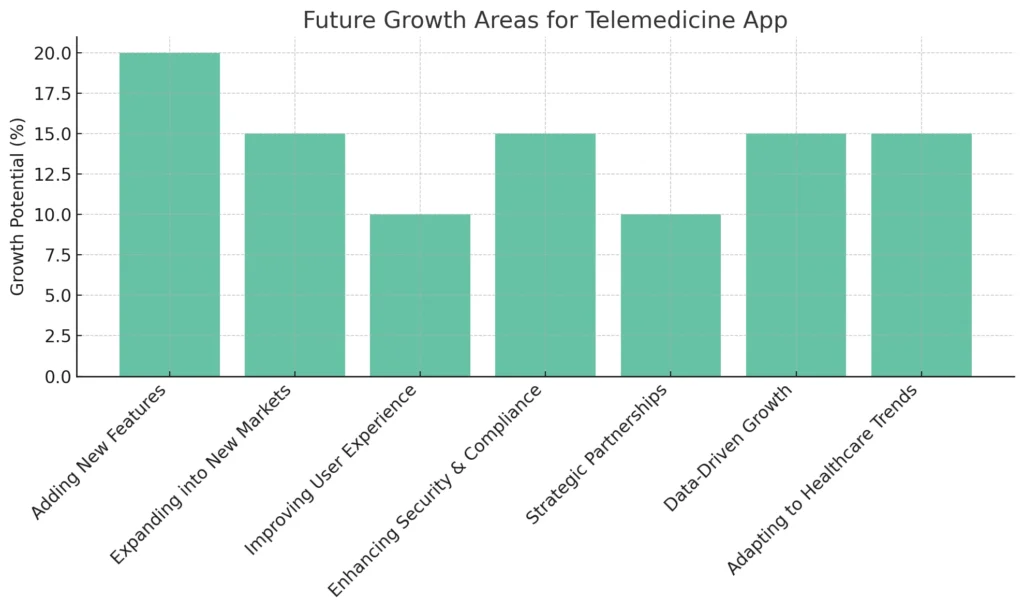
Once your telemedicine app is launched and starts gaining traction, the next step is to focus on its future growth. The healthcare industry is constantly evolving, and staying ahead of trends will help your app remain relevant, competitive, and scalable. Here’s how you can ensure that your app grows and adapts to the changing needs of both users and healthcare professionals.
1. Adding New Features
As your app grows, so will user expectations. One way to ensure continued user engagement is by adding new, innovative features over time. For example, integrating AI-powered symptom checkers or telemonitoring tools that track patient health metrics in real-time can provide more value to users. Introducing specialist consultations or expanding services like mental health counseling and chronic disease management are other ways to cater to a broader audience.
2. Expanding into New Markets
The demand for telemedicine services isn’t limited to specific regions or countries. As your app gains popularity, consider expanding into new geographical markets. This may involve adapting to local regulations, translating the app into different languages, and ensuring that healthcare providers in those regions are licensed and credentialed to practice telemedicine.
3. Improving User Experience
Continuously refining your app’s user experience (UX) is key to keeping users satisfied. By monitoring user feedback and app usage data, you can identify areas for improvement. This might include streamlining the appointment booking process, reducing loading times, or enhancing the design for better accessibility. Offering regular updates that improve the app’s usability will keep users engaged.
4. Enhancing Security and Compliance
As your user base grows, the amount of sensitive healthcare data your app handles will increase. It’s essential to continuously invest in security measures to protect this data. Regularly updating your encryption protocols, ensuring compliance with changing regulations like HIPAA and GDPR, and conducting regular security audits are all critical for maintaining trust with users.
5. Building Strategic Partnerships
Partnering with hospitals, healthcare organizations, and insurance companies can help your app grow faster. These partnerships can open doors to more users, increase the credibility of your platform, and even lead to new revenue streams. Working with health systems can also help you expand your service offerings and integrate your app with traditional healthcare systems.
6. Data-Driven Growth
Leveraging user data can help guide your app’s future growth. Analyzing user behavior, preferences, and healthcare trends will allow you to make informed decisions on what features to add next or which markets to target. By using data analytics, you can personalize the user experience, offering targeted health recommendations or personalized wellness plans that resonate with individual users.
7. Adapting to Future Healthcare Trends
Telemedicine is only the beginning. Future healthcare trends like virtual reality consultations, AI-driven diagnostics, and wearable health tech are on the horizon. By staying informed about emerging technologies, you can position your app to adapt to these changes and remain at the forefront of innovation in the healthcare industry.
By focusing on these growth strategies, you’ll ensure that your app not only remains competitive but also continues to provide meaningful, cutting-edge services to a growing user base.
Why Do You Trust Miracuves Solutions for Your Next Project?
When it comes to building an app like Doctor on Demand, choosing the right development partner can make all the difference. Here’s why Miracuves Solutions should be your trusted choice for creating your next telemedicine app.
1. Unmatched Cost-Effectiveness
Miracuves Solutions offers a significant cost advantage compared to traditional app development processes. With pricing set at just 10% of the global cost, you can develop a high-quality app for a fraction of the cost. While global development prices for a telemedicine app can range from $6,000 to $10,000, Miracuves can deliver the same quality for just $2000, without compromising on features or performance.
2. Rapid Development Time
Speed to market is essential in today’s fast-paced digital world. With Miracuves Solutions, you can have your app ready in as little as 10 days. This incredibly fast turnaround time—compared to the typical development timeframe of 1 month or more globally—means you can get your app live and serving patients faster than your competitors.
3. Ready-Made Solutions
One of the biggest advantages of choosing Miracuves Solutions is their ready-made app solutions. This approach not only saves you time and money but also ensures that the app is built on a proven, reliable framework. You’ll benefit from pre-built features like video consultations, payment gateways, and appointment scheduling, all customizable to your specific needs.
4. Customization Flexibility
Although Miracuves offers ready-made solutions, customization is always available to meet your unique requirements. Whether you want to add advanced features like AI-driven diagnostics or integrate specialized healthcare services, the platform allows for seamless tailoring to fit your business model.
5. Security and Compliance
Telemedicine apps handle sensitive medical data, and ensuring the security of that data is paramount. Miracuves Solutions guarantees HIPAA and GDPR compliance, ensuring that your app meets the highest standards for data privacy and security. You can trust that all patient-doctor communications and personal health information will be safeguarded with the latest encryption and security protocols.
6. Ongoing Support and Maintenance
Building an app is only the beginning—keeping it running smoothly requires ongoing support and maintenance. Miracuves Solutions offers continuous post-launch support, ensuring that your app stays up-to-date, secure, and functional. This comprehensive service guarantees that your platform evolves as your user base grows and new healthcare technologies emerge.
7. Proven Expertise
With a track record of delivering high-quality, functional apps across various industries, Miracuves Solutions has the expertise needed to bring your vision to life. Their experience in developing telemedicine platforms means that they understand the specific challenges of healthcare technology and are well-equipped to handle them.
By choosing Miracuves Solutions, you’re not only saving time and money, but you’re also partnering with a company that prioritizes quality, security, and innovation. Whether you’re looking to launch an MVP quickly or scale your app with advanced features, Miracuves has the tools and expertise to make it happen.
Related Posts :-
- How to Build an App Like Heal: A Complete Guide to On-Demand Doctor App Development
- How to Build a Virtual Healthcare App Like Zocdoc for Medical Scheduling
- Build a Telehealth App Like Amwell: Features, Cost, and Timeline
Conclusion
Building a telemedicine app like Doctor on Demand offers a unique opportunity to tap into the growing healthcare technology sector. With the increasing demand for remote medical consultations, creating an accessible and user-friendly app can help bridge the gap between patients and healthcare providers. The development process may seem complex, but with the right approach, it becomes more manageable.
By focusing on core features like video consultations, secure data handling, and user-friendly design, you can build a solid foundation for your app. Moreover, leveraging ready-made solutions from Miracuves Solutions not only reduces development costs but also significantly shortens the time to market, allowing you to get your app up and running in as little as 10 days at just 10% of the global cost.
As the healthcare industry continues to evolve, staying ahead with innovative features and a scalable platform will ensure your app’s success. With the right strategies in place, your telemedicine app can become a vital tool for improving healthcare access and quality across the globe.
Want to create a telemedicine app like an on-demand doctor service?
We specialize in developing secure, HIPAA-compliant apps that allow instant access to healthcare professionals for consultations, prescriptions, and health advice via video calls, chat, or voice.
FAQs
How much does it cost to build an app like Doctor on Demand?
The global cost to build a telemedicine app can range from $6,000 to $10,000. However, with Miracuves Solutions, you can create the same high-quality app for just 10% of that cost—around $600.
How quickly can I get my telemedicine app live?
With Miracuves Solutions, your app can be developed and launched in as little as 10 days, compared to the typical global timeframe of 1 month or more.
Can I customize the app to fit my specific needs?
Yes! Although Miracuves Solutions offers ready-made solutions, they also allow for full customization, meaning you can add advanced features or tailor the app to your business model.
What security measures are in place to protect patient data?
Miracuves ensures that your app is fully HIPAA and GDPR compliant, with industry-standard encryption and security protocols to protect sensitive healthcare data.
What kind of post-launch support does Miracuves Solutions offer?
Miracuves provides continuous support and maintenance post-launch, ensuring that your app remains up-to-date, secure, and functional as your user base grows.
Explore our on-demand service app solutions offered by Miracuves – built for flexibility, performance, and scalability:
Thumbtack Like Solution – A robust marketplace for connecting users with trusted professionals across categories like home improvement, events, and wellness.
Uber for X Like Solution – A customizable on-demand service framework suited for any niche, with features like real-time booking, GPS tracking, and secure payments.
Rover Like Solution – A pet care service app offering seamless booking for dog walking, pet sitting, and secure communication between pet owners and providers.
Uber for Massage Like Solution – A wellness-focused app that enables users to instantly book certified massage therapists for relaxing doorstep services.
Astrotalk Like Solution – An astrology consultation app offering live sessions, chat with experts, and daily horoscope features like solution.



